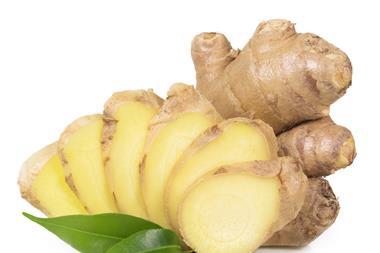How pain receptors play a crucial part in making food delicious
During the Christmas and New Year holidays, you may have found yourself enjoying a gingerbread cookie – or biscuit, if you prefer – with a glass of cold milk. Cookies conjure up flavour memories of sweet, buttery, crumbly deliciousness. Although flavour perception is not yet well understood, it is known that this enjoyment is accompanied by networks of neurons collectively firing and resonating in reaction to sweet, aromatic and textural qualities. Flavour is the emergent property of all the sensory stimuli that occur while eating – and doesn’t just have to be pleasant.1
Warm reception
We think of the tongue as the prime organ for tasting food and detecting nutrients.2 However, from a chemosensory receptor point of view, taste receptors are actually outnumbered by pain and other somatosensory receptors on the tongue. Linda Bartoshuk, a psychologist specialising in taste, has described the small bundles of taste buds on our tongues as being surrounded by large chalices of receptors that are fine-tuned to detect changes in heat energy, physical pressure and chemical irritants – including pain.

It is not unusual for animals to have an abundance of somatosensory receptors as a sort of protective shield or ‘sensory lighthouse’ to warn of environmental hazards. Understandably, we often mix up somatosensory stimulation with taste because they both occur on the tongue. For example, the heat of capsaicin from chillis and the pungent bite of non-volatile vanillylamides in ginger are detected on the tongue not by taste receptors, but by somatosensory receptors – a process referred to as chemesthesis. These receptors are proteins that form transient receptor potential (TRP) channels, which allow ions to flow into nerve cells and contribute to the multimodal signal. Pepparkakor, the Swedish version of gingerbread, contains biochemical extracts from spices that interact more with pain receptors than with those we use to detect simple sugars.
In the balance
It seems incongruous that deliciousness is connected to an assault on our mouth by biochemical plant extracts. Where’s the enjoyment in that? The answer is a psychophysical phenomenon known as mixture suppression:3 the muting of the intensity of individual stimuli when perceived in a mixture. Sugar in your coffee, salt and vinegar on your fish and chips, and cinnamon and clove in pepparkakor are all examples. Identifying these chemesthetic mixtures presents a challenge for food scientists and chefs – harmonious flavours are more difficult to describe than ‘off flavours’.
The ingredients containing chemesthetic agents come primarily from the plant kingdom, and are most prominent in herbs and spices. In pepparkakor, four major ingredients contribute: ginger, cinnamon, cloves and cardamom (see Table 1).4 Each of these ingredients also contributes perceptible volatile compounds (aromas), some unique and some shared by their volatile profiles.
| Table 1. Chemesthetic ingredients in pepparkakor and related perception | |||
|---|---|---|---|
|
Ingredient |
% of dry ingredients |
Compounds contributing to chemesthesis |
Perception |
|
Ginger |
0.68
|
Shogaols; zingerone |
Pungent |
|
Cinnamon |
0.86 |
trans-cinnamaldehyde |
Pungent |
|
Clove |
0.52 |
Eugenol |
Numbing/ cooling |
|
Cardamom |
0.15 |
Eucalyptol |
Numbing |
So as you nibble on your next crumbly and pungent – but not too pungent – batch of gingerbread, consider the balance and harmony in flavour. Use your growing understanding of flavour balance to analyse other foods and understand their harmonious blend of often opposing or contradicting chemical stimuli. Consider how recipes, handed down over the years, forged by preferences and necessity, provide models for chefs and home cooks that describe how culinary techniques influence flavour balance and the hedonic quality of food. Or, alternatively, just enjoy the results.
Recipe book: pepparkakor
Ingredients
- Plain flour 430g
- Baking soda 5g
- Dried ginger 3g
- Cinnamon 4g
- Ground clove 2g
- Ground cardamom 1g
- Butter 110g
- Sugar 150g
- One large egg
- Light molasses 220g
- Grated orange zest 12g
Instructions
- Sift together the flour, baking soda, dried ginger, cinnamon, cloves and cardamom
- In a mixing bowl, cream (beat to soften and incorporate air) the butter and add sugar. Continue to cream until it looks fluffy
- Add in the egg, molasses and grated orange zest, then beat until evenly mixed
- Gradually mix in the spiced flour and leave the bowl to chill in the refrigerator overnight
- Roll out the dough to your desired thickness, cut it into shapes, and bake at 190°C for eight minutes (for dough 0.5cm thick)
- Remove from the oven and allow to cool.
Chris Loss is a culinary scientist based in New York, US
References
1 J Delwiche, Food Qual. Prefer., 19, 137, 2004 (DOI: 10.1016/S0950-3293(03)00041-7)
2 A Efeyan, C Comb and D Sabatini, Nature, 2015, 517, 302 (DOI: 10.1038/nature14190)
3 D McBurney, L Bartoshuk, Phys. Behav., 1973, 10, 1101 (DOI: 10.1016/0031-9384(73)90194-7)
4 S McDonald, D Bolliet and J Hayes, Chemesthesis; chemical touch in food and eating, 2016, West Sussex: John Wiley & Sons












No comments yet